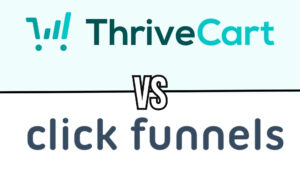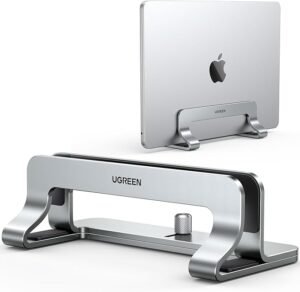When it comes to email marketing, selecting the right platform can make all the difference in reaching your audience effectively and driving results for your business. In this comprehensive comparison, we’ll take a closer look at two popular email marketing platforms: ActiveCampaign vs TinyEmail. By examining their pricing, features, user interface, and more, we’ll help you make an informed decision about which platform is best suited to meet your email marketing needs.
ActiveCampaign vs TinyEmail 2024 – Which is the Best Email Marketing Tool?
Price Comparing
When comparing ActiveCampaign vs TinyEmail, pricing is a crucial factor to consider. Both platforms offer various pricing plans tailored to different needs and budgets.
ActiveCampaign Pricing: ActiveCampaign offers several pricing tiers to accommodate businesses of all sizes. Their plans start with the Lite plan at $9 per month, which includes basic email marketing features such as email marketing automation, segmentation, and unlimited sending for up to 500 contacts. The Plus plan, priced at $49 per month, adds features like CRM with sales automation and contact scoring. The Professional plan, priced at $129 per month, includes advanced automation features, predictive sending, and split automation testing. Finally, the Enterprise plan offers custom pricing and includes additional features such as a dedicated account rep and custom mail server domain.
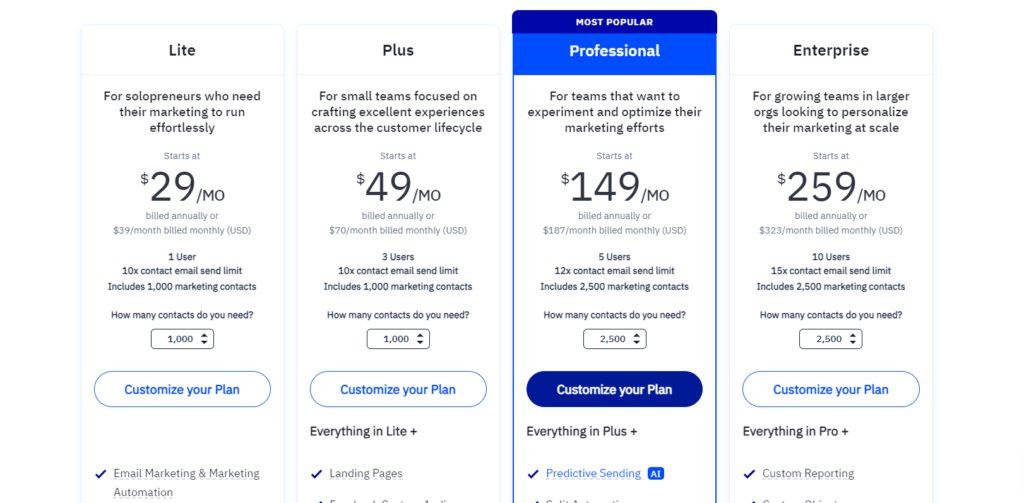
TinyEmail Pricing: TinyEmail, on the other hand, offers simpler pricing with fewer tiers. Their pricing starts at $15 per month for the Basic plan, which includes essential email marketing features like email templates, list management, and basic automation for up to 1,000 subscribers. The Professional plan, priced at $29 per month, adds features like A/B testing, advanced segmentation, and priority support. There is also a Business plan available for larger organizations, with custom pricing based on specific needs.
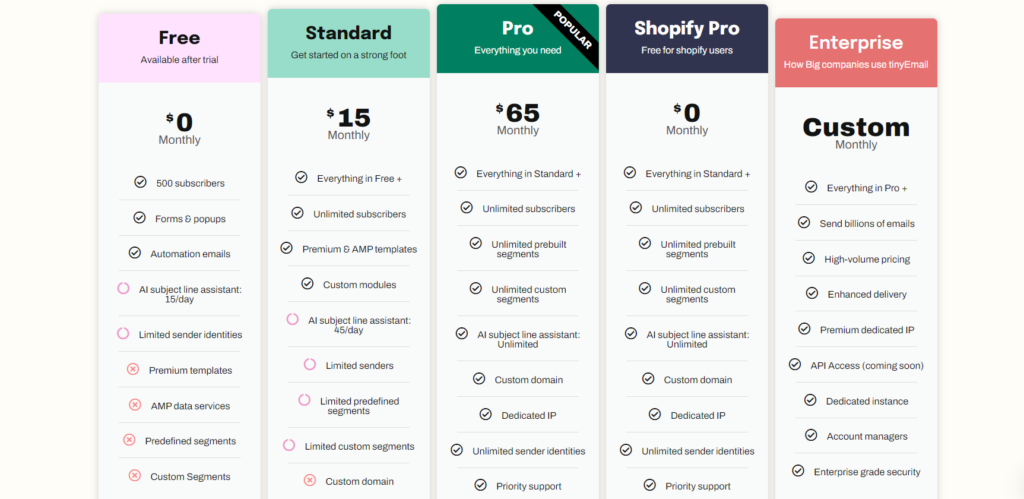
Comparison: In terms of pricing, TinyEmail offers a more straightforward pricing structure compared to ActiveCampaign, making it easier for users to understand and choose the right plan for their needs. However, ActiveCampaign’s Lite plan may be more affordable for small businesses with fewer contacts, while its higher-tier plans offer more advanced features for scaling businesses.
Features ActiveCampaign vs TinyEmail
When comparing ActiveCampaign vs TinyEmail, it’s essential to evaluate the features offered by each platform to determine which one best suits your needs.
ActiveCampaign Features: ActiveCampaign is known for its robust set of features designed to help businesses automate their marketing efforts and improve customer engagement. Some of the key features offered by ActiveCampaign include:
- Email Marketing Automation: ActiveCampaign provides advanced automation capabilities, allowing users to create complex automation workflows based on subscriber behavior, interactions, and triggers.
- Segmentation: Users can segment their email lists based on various criteria, such as demographics, behavior, interests, and engagement level, to send targeted and personalized campaigns.
- CRM Integration: ActiveCampaign offers CRM functionality, allowing users to manage contacts, track interactions, and create deals and pipelines to streamline their sales processes.
- A/B Testing: Users can conduct A/B tests to optimize their email campaigns and improve open rates, click-through rates, and conversions.
- Analytics and Reporting: ActiveCampaign provides detailed analytics and reporting tools to track the performance of email campaigns, automation workflows, and customer interactions.
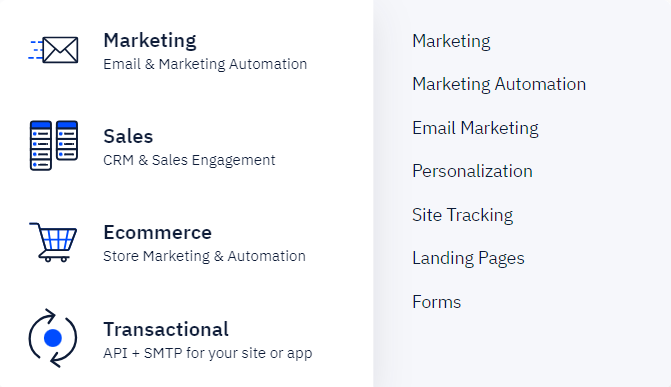
TinyEmail Features: TinyEmail focuses on simplicity and ease of use, offering essential features for email marketing campaigns. Some of the key features offered by TinyEmail include:
- Email Templates: TinyEmail provides a variety of pre-designed email templates to help users create professional-looking campaigns quickly.
- List Management: Users can manage their email lists efficiently, add subscribers, segment lists, and maintain clean and updated contact databases.
- Basic Automation: TinyEmail offers basic automation features, allowing users to set up simple email sequences and autoresponders based on triggers such as sign-ups or specific dates.
- Analytics: Users can track the performance of their email campaigns with basic analytics and reporting tools, including open rates, click-through rates, and bounce rates.
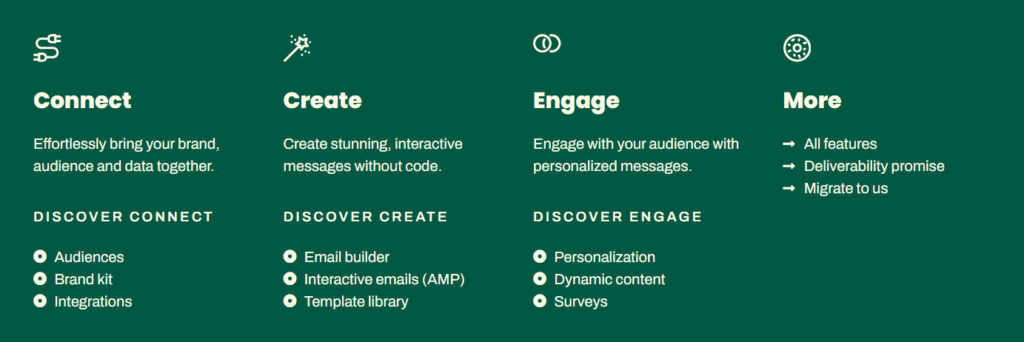
Comparison: In terms of features, ActiveCampaign offers a more comprehensive suite of tools and capabilities compared to TinyEmail. ActiveCampaign’s advanced automation, segmentation, CRM integration, and A/B testing features make it suitable for businesses looking for sophisticated marketing automation solutions. On the other hand, TinyEmail may appeal to users who prefer simplicity and ease of use, with basic features for creating and managing email campaigns.
User Interface
The user interface plays a significant role in the overall user experience of an email marketing platform. Let’s compare the user interfaces of ActiveCampaign vs TinyEmail to see how they stack up.
ActiveCampaign User Interface: ActiveCampaign offers a modern and intuitive user interface designed to streamline the email marketing and automation process. The dashboard provides a clear overview of key metrics, recent activities, and upcoming tasks. Navigation is straightforward, with a sidebar menu providing access to different sections such as campaigns, automation, contacts, and reports. The drag-and-drop email editor makes it easy to create visually appealing email campaigns, with customizable templates and content blocks. Overall, ActiveCampaign’s user interface is clean, organized, and user-friendly, making it easy for users to navigate and manage their marketing campaigns.
TinyEmail User Interface: TinyEmail also prioritizes simplicity and ease of use in its user interface. The dashboard is clean and uncluttered, with a focus on essential tasks such as creating and sending email campaigns. Navigation is straightforward, with a top menu providing access to different features and settings. The email editor is straightforward and easy to use, with basic customization options for creating email content. While TinyEmail’s user interface may lack some of the advanced features and customization options of ActiveCampaign, it excels in simplicity and accessibility, making it suitable for users who prefer a straightforward approach to email marketing.
Comparison: In terms of user interface, both ActiveCampaign vs TinyEmail offer clean and user-friendly interfaces that are easy to navigate. ActiveCampaign’s interface may appeal to users who require more advanced features and customization options, while TinyEmail’s interface is well-suited for users who prioritize simplicity and ease of use.
Email Templates
Email templates are an essential aspect of email marketing, allowing users to create professional-looking campaigns quickly and efficiently. Let’s compare the email templates offered by ActiveCampaign vs TinyEmail to see how they compare.
ActiveCampaign Email Templates: ActiveCampaign provides a wide variety of professionally designed email templates to suit different needs and industries. These templates are fully customizable, allowing users to adjust colors, fonts, images, and content to align with their brand and message. The templates cover various types of email campaigns, including newsletters, promotional offers, event invitations, and more. Additionally, ActiveCampaign offers responsive templates that adapt to different screen sizes, ensuring that emails look great on desktop and mobile devices alike.
TinyEmail Email Templates: TinyEmail also offers a selection of email templates to help users create visually appealing campaigns. While the template library may be smaller compared to ActiveCampaign, TinyEmail’s templates are designed with simplicity and ease of use in mind. Users can choose from basic layouts and designs and customize them with their branding and content. The templates are responsive by default, ensuring that emails display properly across different devices.
Comparison: In terms of email templates, ActiveCampaign offers a more extensive library of professionally designed templates with greater customization options. This makes it suitable for users who prioritize design flexibility and brand consistency. On the other hand, TinyEmail’s templates are more straightforward and may appeal to users who prefer simplicity and ease of use.
Customer Support
Customer support is a critical aspect of any software service, ensuring that users receive assistance and guidance when needed. Let’s compare the customer support options offered by ActiveCampaign vs TinyEmail.
ActiveCampaign Customer Support: ActiveCampaign provides robust customer support options to assist users with their email marketing needs. Users can access support via email, live chat, and phone during business hours. Additionally, ActiveCampaign offers a comprehensive knowledge base with articles, tutorials, guides, and video tutorials to help users troubleshoot issues and learn how to use the platform effectively. ActiveCampaign also provides premium support options for users on higher-tier plans, including priority support and dedicated account managers.
TinyEmail Customer Support: TinyEmail offers customer support via email and a support ticket system. While TinyEmail’s support options may be more limited compared to ActiveCampaign, they strive to provide timely and helpful assistance to users. Additionally, TinyEmail provides a knowledge base with articles and tutorials to help users get started and troubleshoot common issues.
Comparison: In terms of customer support, ActiveCampaign offers more comprehensive support options with live chat, phone support, and a dedicated knowledge base. This makes it easier for users to get assistance when needed and find answers to their questions. On the other hand, TinyEmail’s support options may be more limited, but they still aim to provide helpful assistance to users through email and support tickets.
Integrations
Integrations play a crucial role in extending the functionality of email marketing platforms by allowing users to connect with other software and tools. Let’s compare the integrations offered by ActiveCampaign vs TinyEmail.
ActiveCampaign Integrations: ActiveCampaign offers a wide range of integrations with other software and tools, making it easy for users to streamline their workflows and connect their email marketing efforts with other aspects of their business. Some of the key integrations available with ActiveCampaign include:
- CRM Systems: ActiveCampaign integrates seamlessly with popular CRM systems such as Salesforce, HubSpot, and Pipedrive, allowing users to sync contacts, track interactions, and automate sales processes.
- E-commerce Platforms: ActiveCampaign integrates with e-commerce platforms like Shopify, WooCommerce, and Magento, enabling users to automate email marketing campaigns based on customer purchase behavior, abandoned carts, and more.
- Analytics Tools: ActiveCampaign integrates with analytics tools such as Google Analytics and Facebook Pixel, allowing users to track the performance of their email campaigns and website traffic.
TinyEmail Integrations: TinyEmail also offers integrations with other software and tools, although the selection may be more limited compared to ActiveCampaign. Some of the key integrations available with TinyEmail include:
- CRM Systems: TinyEmail integrates with CRM systems like Zoho CRM and Freshsales, allowing users to sync contacts and track interactions between email marketing campaigns and sales activities.
- E-commerce Platforms: TinyEmail integrates with e-commerce platforms such as BigCommerce and Ecwid, enabling users to create targeted email marketing campaigns based on customer purchase history and behavior.
- Social Media Platforms: TinyEmail integrates with social media platforms like Facebook and Twitter, allowing users to share email marketing campaigns and track social engagement metrics.
Comparison: In terms of integrations, ActiveCampaign offers a more extensive selection of integrations with a wider range of software and tools. This makes it easier for users to connect ActiveCampaign with their existing systems and create seamless workflows. On the other hand, TinyEmail’s integrations may be more limited, but they still provide essential integrations for connecting with CRM systems, e-commerce platforms, and social media platforms.
Deliverability
Email deliverability refers to the ability of an email marketing platform to successfully deliver emails to recipients’ inboxes, rather than being flagged as spam or ending up in the junk folder. Let’s compare the deliverability rates of ActiveCampaign vs TinyEmail.
ActiveCampaign Deliverability: ActiveCampaign prioritizes email deliverability and employs various strategies to ensure that emails sent through their platform reach recipients’ inboxes. Some of the factors that contribute to ActiveCampaign’s high deliverability rates include:
- Sender Reputation: ActiveCampaign maintains a good sender reputation by adhering to industry best practices and maintaining low spam complaint rates.
- Email Authentication: ActiveCampaign supports email authentication protocols such as SPF, DKIM, and DMARC, which help verify the authenticity of sender domains and improve deliverability.
- Anti-Spam Measures: ActiveCampaign monitors for spammy content and behavior and takes proactive measures to prevent emails from being flagged as spam.
TinyEmail Deliverability: TinyEmail also focuses on ensuring high deliverability rates for emails sent through their platform. While specific details about TinyEmail’s deliverability practices may vary, they likely employ similar strategies as ActiveCampaign to maintain good deliverability rates.
Comparison: In terms of deliverability, both ActiveCampaign and TinyEmail strive to ensure that emails sent through their platforms reach recipients’ inboxes. While specific deliverability rates may vary depending on factors such as sender reputation and email content, both platforms are committed to maintaining high deliverability rates and minimizing the risk of emails being flagged as spam.
Scalability
Scalability refers to the ability of an email marketing platform to accommodate the needs of growing businesses and handle increasing volumes of contacts and email campaigns. Let’s compare the scalability of ActiveCampaign and TinyEmail.
ActiveCampaign Scalability: ActiveCampaign is designed to scale with businesses of all sizes, offering flexible pricing plans and advanced features to meet the needs of growing organizations. Some of the scalability features offered by ActiveCampaign include:
- Flexible Pricing Tiers: ActiveCampaign offers pricing plans that cater to businesses of different sizes and budgets, with options to upgrade or downgrade as needed.
- Unlimited Contacts: ActiveCampaign’s higher-tier plans offer unlimited contacts, allowing businesses to grow their email lists without worrying about hitting contact limits.
- Advanced Automation: ActiveCampaign’s automation features are highly scalable, allowing businesses to create complex automation workflows and scale their marketing efforts as they grow.
- API Integrations: ActiveCampaign offers robust API integrations, allowing businesses to connect with other systems and tools to streamline workflows and scale their operations.
TinyEmail Scalability: TinyEmail also offers scalability features to accommodate the needs of growing businesses, although the extent of scalability may be more limited compared to ActiveCampaign. Some scalability features offered by TinyEmail include:
- Tiered Pricing: TinyEmail offers tiered pricing plans with options to upgrade or downgrade as needed, making it suitable for businesses of different sizes and budgets.
- Contact Limits: TinyEmail’s pricing plans may include contact limits, which could potentially impact scalability for businesses with large email lists.
- Basic Automation: While TinyEmail offers basic automation features, the scalability of these features may be more limited compared to ActiveCampaign’s advanced automation capabilities.
Comparison: In terms of scalability, ActiveCampaign offers more extensive scalability features and flexibility compared to TinyEmail. ActiveCampaign’s flexible pricing plans, unlimited contacts, advanced automation, and API integrations make it well-suited for businesses looking to scale their email marketing efforts. On the other hand, TinyEmail may be suitable for smaller businesses with simpler email marketing needs, but scalability options may be more limited.
User Reviews
User reviews provide valuable insights into the experiences of real users with ActiveCampaign vs TinyEmail. Let’s explore some user reviews to understand how each platform is perceived by its users.
ActiveCampaign User Reviews: Many users praise ActiveCampaign for its robust features, automation capabilities, and ease of use. Users appreciate the flexibility of ActiveCampaign’s automation workflows and its ability to integrate with other software and tools seamlessly. Some users also highlight ActiveCampaign’s excellent customer support and extensive knowledge base, which provide helpful resources for getting started and troubleshooting issues.
TinyEmail User Reviews: TinyEmail receives positive feedback from users who value its simplicity, affordability, and user-friendly interface. Users appreciate TinyEmail’s straightforward approach to email marketing and its ability to create professional-looking campaigns quickly. Some users also commend TinyEmail’s responsive customer support team, which provides timely assistance and resolves issues promptly.
Comparison: In general, both ActiveCampaign vs TinyEmail receive positive reviews from users, with each platform catering to different needs and preferences. ActiveCampaign is favored by users who require advanced automation features, extensive integrations, and scalability options. On the other hand, TinyEmail appeals to users who prioritize simplicity, affordability, and ease of use in their email marketing efforts.
Conclusion
In conclusion, both ActiveCampaign and TinyEmail are powerful email marketing platforms that offer a range of features and capabilities to help businesses engage with their audience and drive results.
ActiveCampaign stands out for its advanced automation features, extensive integrations, and scalability options, making it suitable for businesses of all sizes looking for sophisticated marketing automation solutions. With flexible pricing plans, excellent customer support, and a comprehensive knowledge base, ActiveCampaign provides users with the tools and resources they need to succeed in their email marketing efforts.
TinyEmail, on the other hand, excels in simplicity, affordability, and ease of use. With straightforward pricing plans, user-friendly interface, and responsive customer support, TinyEmail is ideal for small businesses and beginners who prioritize simplicity and efficiency in their email marketing campaigns. While it may lack some of the advanced features and customization options of ActiveCampaign, TinyEmail provides essential tools for creating and managing email campaigns effectively.
Ultimately, the choice between ActiveCampaign vs TinyEmail depends on your specific needs, preferences, and budget. If you require advanced automation capabilities, extensive integrations, and scalability options, ActiveCampaign may be the right choice for you. However, if you prefer simplicity, affordability, and ease of use, TinyEmail could be the perfect solution for your email marketing needs.
Regardless of which platform you choose, both ActiveCampaign vs TinyEmail offer valuable features and resources to help you connect with your audience, grow your business, and achieve your marketing goals.




